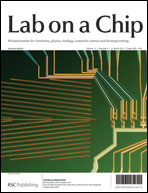Fundamentals of inertial focusing in microchannels
Abstract
Inertial microfluidics has been attracting considerable interest in recent years due to immensely promising applications in cell biology. Despite the intense attention, the primary focus has been on development of inertial microfluidic devices with less emphasis paid to elucidation of the inertial focusing mechanics. The incomplete understanding, and sometimes confusing experimental results that indicate a different number of focusing positions in square or rectangular microchannels under similar flow conditions, have led to poor guidelines and difficulties in design of inertial microfluidic systems. In this work, we describe and experimentally validate a two-stage model inertial focusing in microchannels. Our analysis and experimental results show that not only the well-accepted shear-induced and wall-induced lift forces act on particles within flow causing equilibration near microchannel sidewalls, but the rotation-induced lift force influences the position of these equilibria. In addition, for the first time, we experimentally measure lift coefficients, which previously could only be obtained from numerical simulations. More importantly, insights offered by our two-stage model of inertial focusing are broadly applicable to cross-sectional geometries beyond rectangular. With elucidation of the equilibration mechanism, we envision better guidelines for the inertial microfluidics community, ultimately leading to improved performance and broader acceptance of the inertial microfluidic devices in a wide range of applications, from


 Please wait while we load your content...
Please wait while we load your content...